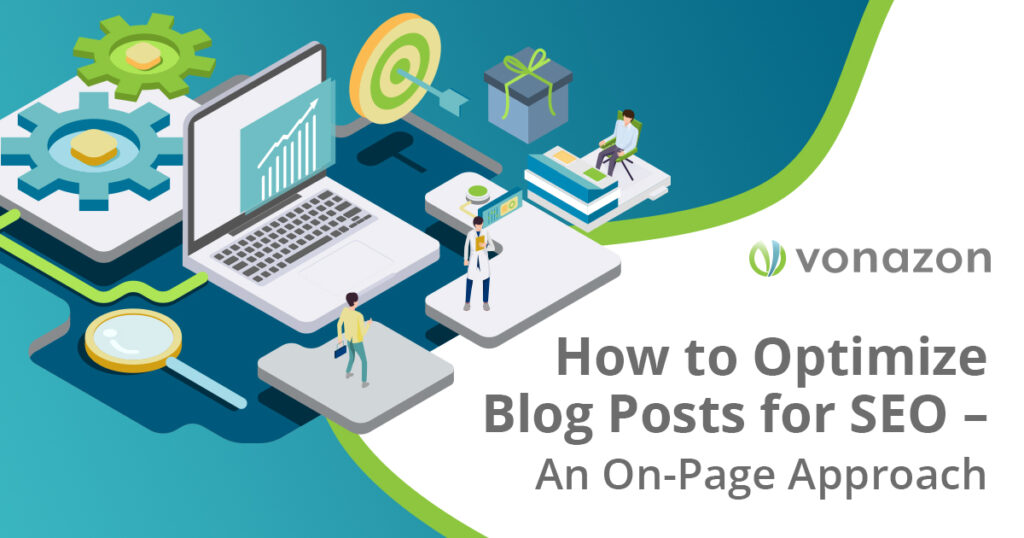
How to Optimize Blog Posts for SEO – An On-Page Approach
Creating a blog is one of the most effective strategies for increasing traffic to your website and building brand awareness. It’s how you get people to see your website by using search engines like Google. Here are the facts:
- Companies with active blogs produce 67% more leads.
- Updating blog posts can result in a 106% increase in traffic.
- Blog posts are more effective than email, e-books, and white paper content.
However, you can spend a lot of time and money creating content for your blog only to discover that you’re getting little to no traffic. If this is the case, your blog posts aren’t SEO-optimized for higher search engine rankings.
In this article, we’ll give you tips on how to optimize blog posts for SEO using the on-page approach. For clarification, on-page SEO refers to everything you do on a page to help it rank higher in search engines.
So without further ado, here are 10 actionable tips and strategies on how to optimize blog posts for SEO.
1. Choose The Right Topic Based On Keyword Research
While there is virtually no end to the topics you could write about, you’ll need to focus your efforts on writing:
- Topics that are relevant and valuable to your target audience.
- Non-competitive topics that can rank you on the first page of Google.
The reason is that the first position on Google for a given query receives an average click-through rate of 19.3%. Then, at 10.57% CTR, we see a significant drop for the second position, almost by half. Even more shocking is the fact that 75% of all searchers never scroll past the first page of results.
Finding the most relevant topics that have a higher chance of ranking centers around keyword research.
You can gather valuable search engine data using keyword research tools like SEMRush or Ahrefs to discover topics that your users are interested in. These tools also provide a keyword difficulty score, which indicates whether a particular keyword is worth pursuing.
We recommend you focus on long-tail keywords. These are keywords with low search volume, low competition, and a narrow focus that can help you rank higher. For example, instead of using “SEO Blog Posts,” you could go for “How to write SEO Blog Posts that Get Traffic.”
2. Optimize Your Headline
A well-written title will not only help a post rank higher but will also increase the likelihood that your target audience will click on the blog post and read it.
As for structure, your target keyword should be placed as close to the beginning of the headline as possible. Because when someone skims through the search results, they’ll look for the headlines that most closely match their query. It will be easier to notice your keyword if it appears first.
However, don’t sacrifice the quality of the headline just to include the keyword at the start.
3. Use Your Main Keyword in The Subheadings
After the headline, the subheadings are the next place to include your keyword. These subheadings should be marked with the H2 and H3 tags, depending on their hierarchy and the structure of the article.
subheadings make it easier to read while also allowing you to skim through the post. Most people scan a blog post before reading it, so using subheadings can help them find the sections they’re looking for and give them a good idea of the content.
In essence, you’re informing readers and search engines about the topic of your blog post with subheadings. Google can better decide how to rank your webpage, while readers will decide whether they want to read it.
4. Link Internally and Externally
To begin, use links to help other pages on your site to gain page authority. You can use a topic cluster model, in which you create content based on specific keywords that are related to a main, broader topic and then link them together. This will help you establish your authority on the topic and better meet the searcher’s intent. Make sure you do this for both your new and older blog posts for maximum effectiveness.
You should also link to highly authoritative websites to provide even more value to your readers and improve user experience. This will not only increase your credibility but will also help Google better understand the content of your post.
Make sure the anchor text you use corresponds to the link’s content. An anchor text that says, “a guide to writing killer headlines” should, for example, link to a relevant post.
5. Use Visuals And Add Your Keywords in The Alt Text
Did you know that the brain transmits 90% of its data visually? This is why it can work in your favor to include images in your blog posts and optimize them for SEO.
Google and other search engines frequently favor engaging content. And plain text is not as engaging as images and videos.
To better illustrate the meaning of your content, you should start by adding visuals like infographics, photographs, and others. After that, try to add alt text to the visuals you add that describe their content while attempting to include your keyword.
Although artificial intelligence allows modern search engines to recognize an image and its content, they still rely on user-generated alt texts for more accuracy.
6. Include Your Keywords in The Meta Description
A good meta description can tell you a lot about the content you’re reading. It is also displayed when your articles are shared on social media platforms like Facebook, Twitter, and LinkedIn. As a result, writing a meta description that is both relevant and descriptive will help you get more clicks.
You can also use your focus keyword at least once within the meta description to improve your ranking.
But keep in mind that your description should be no more than 155 characters long. This is because if you don’t, search engines will trim them.
7. Make Your URL Structure User-Friendly
Your website’s URL structure should make it easy for visitors to understand the structure of your site and the content they’re about to see.
For readers, URLs serve as a categorization system, letting them know where they are on the website and how to get to new pages. This is also important for search engines because it makes it easier to determine what information searchers will access on various parts of your blog or website. It also helps to include your main keyword in your URLs.
8. Don’t Go Overboard With Tags
Tags can help you organize your posts into subcategories for easier navigation and so that search engines can understand what you’re talking about. However, if you use too many tags, your posts may be flagged as duplicate content, which Google and other search engines will penalize.
We recommend you use between 3 and 5 relevant tags to your post, but no more.
Conclusion
We showed you 8 actionable tips on how to optimize blog posts for SEO in this article. But keep in mind that you’re trying to rank higher and get more free traffic to your website, while also trying to provide value to your readers. So, if you believe that a particular SEO technique is jeopardizing the quality of your content, you can skip it.
Need SEO support? Contact us today and speak with an SEO specialist!
Account Executive
Vonazon Inc.

Vonazon can guide you through the process of creating fun and effective short form videos that are unique to your brand. We can also help you create campaigns around your videos that deliver results, grow your brand’s social media presence, and produce more leads.
Contact us today to begin your short form video journey.
Recent Posts
Categories
Categories
- ABM
- Account Management
- Analytics
- Artificial Intelligence
- Content Marketing
- Creative
- CRM
- Design
- eCommerce
- Email Marketing
- HubSpot
- HubSpot CRM
- HubSpot Marketing Hub
- HubSpot Partner
- Inbound Marketing
- Integrations and Migrations
- Lead Generation
- Lead Scoring
- Marketing
- Marketing Automation
- Marketing Strategy
- Native Advertising
- Omnichannel Marketing
- Organization
- PPC
- Programmatic Advertising
- Sales and Marketing Alignment
- SEO
- Social Media
- Staffing
- Trade Shows
- Videos
- Web Development
- Webinars
HOW CAN We
HELP YOU?
Lorem ipsum dolor sit amet, consectetur adipiscing elit.




